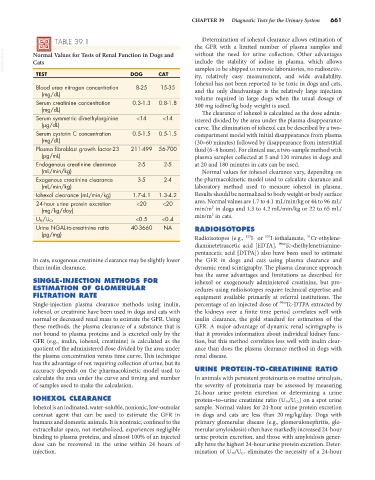Page 689 - Small Animal Internal Medicine, 6th Edition
P. 689
CHAPTER 39 Diagnostic Tests for the Urinary System 661
Determination of iohexol clearance allows estimation of
TABLE 39.1 the GFR with a limited number of plasma samples and
VetBooks.ir Normal Values for Tests of Renal Function in Dogs and without the need for urine collection. Other advantages
include the stability of iodine in plasma, which allows
Cats
TEST DOG CAT samples to be shipped to remote laboratories, no radioactiv-
ity, relatively easy measurement, and wide availability.
Iohexol has not been reported to be toxic in dogs and cats,
Blood urea nitrogen concentration 8-25 15-35
(mg/dL) and the only disadvantage is the relatively large injection
Serum creatinine concentration 0.3-1.3 0.8-1.8 volume required in large dogs when the usual dosage of
300 mg iodine/kg body weight is used.
(mg/dL) The clearance of iohexol is calculated as the dose admin-
Serum symmetric dimethylarginine <14 <14 istered divided by the area under the plasma disappearance
(µg/dL) curve. The elimination of iohexol can be described by a two-
Serum cystatin C concentration 0.5-1.5 0.5-1.5 compartment model with initial disappearance from plasma
(mg/dL) (30–60 minutes) followed by disappearance from interstitial
Plasma fibroblast growth factor-23 211-499 56-700 fluid (6–8 hours). For clinical use, a two-sample method with
(pg/mL) plasma samples collected at 5 and 120 minutes in dogs and
Endogenous creatinine clearance 2-5 2-5 at 20 and 180 minutes in cats can be used.
(mL/min/kg) Normal values for iohexol clearance vary, depending on
Exogenous creatinine clearance 3-5 2-4 the pharmacokinetic model used to calculate clearance and
(mL/min/kg) laboratory method used to measure iohexol in plasma.
Iohexol clearance (mL/min/kg) 1.7-4.1 1.3-4.2 Results should be normalized to body weight or body surface
24-hour urine protein excretion <20 <20 area. Normal values are 1.7 to 4.1 mL/min/kg or 44 to 96 mL/
2
(mg/kg/day) min/m in dogs and 1.3 to 4.2 mL/min/kg or 22 to 65 mL/
2
<0.5 <0.4 min/m in cats.
U Pr /U Cr
Urine NGAL-to-creatinine ratio 40-3660 NA RADIOISOTOPES
(pg/mg)
Radioisotopes (e.g., 125 I- or 131 I-iothalamate, Cr-ethylene-
51
diaminetetraacetic acid [EDTA], 99m Tc-diethylenetriamine-
pentaacetic acid [DTPA]) also have been used to estimate
In cats, exogenous creatinine clearance may be slightly lower the GFR in dogs and cats using plasma clearance and
than inulin clearance. dynamic renal scintigraphy. The plasma clearance approach
has the same advantages and limitations as described for
SINGLE-INJECTION METHODS FOR iohexol or exogenously administered creatinine, but pro-
ESTIMATION OF GLOMERULAR cedures using radioisotopes require technical expertise and
FILTRATION RATE equipment available primarily at referral institutions. The
Single-injection plasma clearance methods using inulin, percentage of an injected dose of 99m Tc-DTPA extracted by
iohexol, or creatinine have been used in dogs and cats with the kidneys over a finite time period correlates well with
normal or decreased renal mass to estimate the GFR. Using inulin clearance, the gold standard for estimation of the
these methods, the plasma clearance of a substance that is GFR. A major advantage of dynamic renal scintigraphy is
not bound to plasma proteins and is excreted only by the that it provides information about individual kidney func-
GFR (e.g., inulin, iohexol, creatinine) is calculated as the tion, but this method correlates less well with inulin clear-
quotient of the administered dose divided by the area under ance than does the plasma clearance method in dogs with
the plasma concentration versus time curve. This technique renal disease.
has the advantage of not requiring collection of urine, but its
accuracy depends on the pharmacokinetic model used to URINE PROTEIN-TO-CREATININE RATIO
calculate the area under the curve and timing and number In animals with persistent proteinuria on routine urinalysis,
of samples used to make the calculation. the severity of proteinuria may be assessed by measuring
24-hour urine protein excretion or determining a urine
IOHEXOL CLEARANCE protein–to–urine creatinine ratio (U Pr /U Cr ) on a spot urine
Iohexol is an iodinated, water-soluble, nonionic, low-osmolar sample. Normal values for 24-hour urine protein excretion
contrast agent that can be used to estimate the GFR in in dogs and cats are less than 20 mg/kg/day. Dogs with
humans and domestic animals. It is nontoxic, confined to the primary glomerular disease (e.g., glomerulonephritis, glo-
extracellular space, not metabolized, experiences negligible merular amyloidosis) often have markedly increased 24-hour
binding to plasma proteins, and almost 100% of an injected urine protein excretion, and those with amyloidosis gener-
dose can be recovered in the urine within 24 hours of ally have the highest 24-hour urine protein excretion. Deter-
injection. mination of U Pr /U Cr eliminates the necessity of a 24-hour

